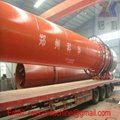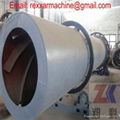Now as energy shortage becomes a big concern of governments all over the world, governments encourage and support companies, universities, institutions to research energy issues. Biomass dryer emerges in recent years under such circumstances. With biomass dryer, many waste in agriculture and forestry in the past becomes now new energy supply after drying process, such as animal manure, sawdust, wood shaving, wood chips, forage, palm fiber, alfalfa, husk, straw, etc.
There are several variations of biomass dryer, but the most widely-used is the directly heated single-pass biomass dryer. In this type of dryer, hot gases are contacted with biomass material inside a rotating drum. The rotation of drum lifts solids in biomass dryer, so they can tumble through the hot gas, promoting better mass and heat transfer. If contamination is not a concern, hot flu gas can be fled directly into the air. Or, it has to be processed by cyclone dust collector.
The biomass and hot air normally flow co-currently through biomass dryer so the hottest gases come in contact with wettest materials. But for materials where temperature is not a concern, the flue gas and materials flow in opposite directions, so the driest materials are exposed to the hottest gases with the lowest moisture.
Indirectly heated biomass dryer uses a heat source-steam or hot air-passing through the outer wall of biomass dryer or through an inner central shaft to heat biomass dryer by conduction. In this way, a high flu gas temperature can be used for heating while reducing the fire risk by limiting the temperature of the gas in direct contact with the biomass.











